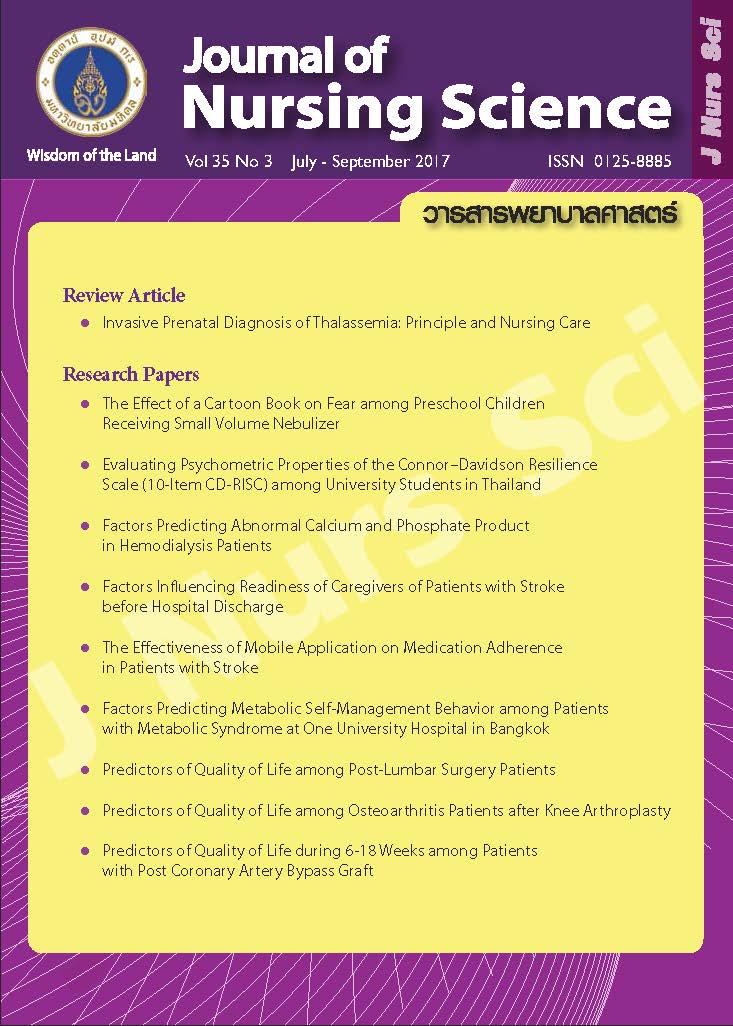Factors Predicting Abnormal Calcium and Phosphate Product in Hemodialysis Patients ปัจจัยทำนายความผิดปกติของผลคูณแคลเซียมและฟอสเฟตในผู้ป่วยฟอกเลือดด้วยเครื่องไตเทียม
Main Article Content
Abstract
Purpose: This study was a predictive research design aimed to study the predictive power of age, co-morbidities, albumin levels, and phosphate control behaviors of abnormal calcium-phosphate product in hemodialysis (HD) patients.
Design: Correlation predictive design.
Methods: The sample composed of 120 HD patients who met the inclusion criteria and received services at the Kidney Foundation of Thailand. Data were collected by using the Demographic Data Record Form, the Serum Phosphate Control Behavior Questionnaire. Data were analyzed using descriptive statistics and logistic regression.
Main finding: Phosphate control behavior could predict abnormal calcium phosphate product (odds ratio = .98, 95%CI = .95 - 1.01, p < .05). Serum albumin was a factor capable of predicting abnormal calcium phosphate product in hemodialysis patients (odds ratio = .42, 95%CI = .22 - .82, p < .05). All variables significantly predicted abnormalities in abnormal calcium and phosphate values at 14% (R² = .14, p < .05).
Conclusion and recommendations: Phosphate control behavior and serum albumin are able to predict calcium and phosphate product in hemodialysis patients. So, nurses should encourage and support dietaries behaviors for correct practice of patients in order to control calcium and phosphate product in hemodialysis patients.
บทคัดย่อ
วัตถุประสงค์: เพื่อศึกษาอำนาจการทำนายของ อายุ โรคร่วม ระดับอัลบูมินในเลือด พฤติกรรมการควบคุมฟอสเฟตในเลือด ต่อความผิดปกติของผลคูณแคลเซียมและฟอสเฟตในผู้ป่วยฟอกเลือดด้วยเครื่องไตเทียม
รูปแบบการวิจัย: การศึกษาความสัมพันธ์เชิงทำนาย
วิธีดำเนินการวิจัย: ผู้ป่วยฟอกเลือดด้วยเครื่องไตเทียมมูลนิธิโรคไตแห่งประเทศไทย จำนวน 120 คน เก็บรวบรวมข้อมูลโดยให้กลุ่มตัวอย่างตอบแบบสอบถามข้อมูลส่วนบุคคล แบบสอบถามพฤติกรรมการควบคุมฟอสเฟต วิเคราะห์ข้อมูลทั่วไปด้วยสถิติเชิงบรรยาย และวิเคราะห์อำนาจการทำนายด้วยสมการถดถอยโลจิสติก
ผลการวิจัย: พบว่าพฤติกรรมการควบคุมฟอสเฟต เป็นปัจจัยที่สามารถทำนายความผิดปกติของค่าผลคูณของแคลเซียมและฟอสเฟต (odds ratio = .98, 95%CI = .95 - 1.01, p < .05) ระดับอัลบูมินในเลือดสามารถทำนายความผิดปกติของผลคูณแคลเซียมและฟอสเฟตในผู้ป่วยฟอกเลือดด้วยเครื่องไตเทียม (odds ratio = .42, 95%CI = .22 - .82, p < .05) และสามารถร่วมทำนายความผิดปกติของผลคูณแคลเซียมและฟอสเฟตได้ร้อยละ 14 (R² = .14, p < .05)
สรุปและข้อเสนอแนะ: พฤติกรรมการควบคุมฟอสเฟต และระดับอัลบูมินในเลือดสามารถทำนายความผิดปกติของผลคูณแคลเซียมและฟอสเฟตได้ ดังนั้นพยาบาลควรสนับสนุนและส่งเสริมพฤติกรรมการบริโภคอาหารของผู้ป่วยให้ปฏิบัติได้ถูกต้องเพื่อควบคุมผลคูณของแคลเซียมและฟอสเฟต ให้อยู่ในเกณฑ์ที่เหมาะสมในผู้ป่วยฟอกเลือดด้วยเครื่องไตเทียม
Article Details
Copyright Notice: Nursing Science Journal of Thailand has exclusive rights to publish and distribute the manuscript and all contents therein. Without the journal’s permission, the dissemination of the manuscript in another journal or online, and the reproduction of the manuscript for non-educational purpose are prohibited.

Disclaimer: The opinion expressed and figures provided in this journal, NSJT, are the sole responsibility of the authors. The editorial board bears no responsibility in this regard.
References
2. National Kidney Foundation. K/DOQI clinical practice guidelines for chronic kidney disease: evaluation, classification, and stratification. Am J Kidney Dis 2002; 39(2 Suppl 1):1-266.
3. Astor BC, Matsushita K, Gansevoort RT, van der Velde M, Woodward M, Levey AS, et al. Lower estimated glomerular filtration rate and higher albuminuria are associated with mortality and end stage renal disease. A collaborative meta-analysis of kidney disease population cohorts. Kidney Int. 2011;79(12):1331-40.
4. Kidney Disease: Improving Global Outcomes (KDIGO) CKD-MBD Work Group. KDIGO clinical practice guideline for the diagnosis evaluation, prevention, and treatment of chronic kidney disease-mineral and bone disorder (CKD-MBD). Kidney Int Suppl. 2009 Aug;(113):S1-130. doi:10.1038/ki.2009.188. PubMed PMID: 19644521.
5. Lim CT, Yap XH, Chung KJ, Khalid MA, Yayha N, Latiff LA, et al. Predictor of cardiovascular risks in end stage renal failure patients on maintenance dialysis. Pak J Med Sci. 2015;31(6):1300-5.
6. Thongthiam S, Sriyuktasuth A, Saneha C, Leelahavanichkul A. The influences of sleep quality, nutritional status, and co-morbidity on quality of life in patients with predialysis chronic kidney disease. Journal of Nursing Science. 2016;34(1):42-52. (in Thai).
7. Zhang K, Cheng G, Cai X, Chen J, Jiang Y, Wang T, et al. Malnutrition, a new inducer for arterial calcification in hemodialysis patients? J Transl Med. 2013 Mar 18;11:66. doi: 10.1186/1479-5876-11-66. PubMed PMID: 23506394; PubMed Central PMCID: PMC3608064.
8. Henrich WL. Principles and practice of dialysis. 4th ed. Philadelphia: Lippincott Williams & Wilkings; 2009.
9. Foley RN, Collins AJ, Ishani A, Kalra PA. Calcium-phosphate levels and cardiovascular disease in community-dwelling adults: the Atherosclerosis Risk in Communities (ARIC) Study. Am Heart J. 2008;156(3):556-63.
10. Vanichbuncha K. Advanced statistics analysis SPSS for Window. 2th ed. Bangkok: Bunnasarn Company; 2005. (in Thai).
11. Suwanpyrat J. Sangkard J, Kimpee S, Sriyuktasuth A. Factors influencing serum phosphate control behaviors in hemodialysis patients. Journal of the Nephrology Society of Thailand. 2012;15(4):37-43. (in Thai).
12. Berbari AE, Daouk NA, Daouk MM. Chronic kidney disease and renovascularinteractions. In: Berbari AE, Mancia G, editors. Arterial disorders: definition, clinical manifestations, mechanisms and therapeutic approaches. Switzerland: Springer International Publishing; 2015. p.299-312.
13. Kato A, Takita T, Furuhashi M, Fujimoto T, Suzuki H, Hakamada M, et al. Influence of the assay for measuring serum albumin on corrected total calcium in chronic hemodialysis patients. Ther Apher Dial. 2011;15(6):540-6.
14. Honkanen E, Kauppila L, Wikström B, Rensma PL, Krzesinski JM, Aasarod K, et al. Abdominal aortic calcification in dialysis patients: results of the CORD study. Nephrol Dial Transplant. 2008;23(12):4009-15.
15. Edmonds ME. Medial arterial calcification and diabetes mellitus. Z Kardiol. 2000;89 Suppl 2:101-4
16. Jintana P, Sriyuktasuth A, Pongthavornkamol K, Nata N. Information-motivation-behavioral skills program improved phosphate binder adherence in patients with chronic hemodialysis. Journal of Nursing Science. 2016;34(2):92-101. (in Thai).
17. Dhingra R, Sullivan LM, Fox CS, Wang TJ, D’Agostino RB Sr, Gaziano JM, et al. Relations of serum phosphorus and calcium levels to the incidence of cardiovascular disease in the community. Arch Intern Med. 2007;167(9):879-85.
18. Takeda E, Yamamoto H, Nishida Y, Sato T, Sawada N, Taketani Y. Phosphate restriction in diet therapy. Contrib Nephrol. 2007;155:113-24. doi: 10.1159/0000101004. PubMed PMID: 17369719.
19. Thanakitcharu P. Current situation of chronic kidney disease in Thailand. Journal of the Department of Medical Services. 2015;5(1):5-18. (in Thai).
20. Goodman WG, Goldin J, Kuizon BD, Yoon C, Gales B, Sider D, et al. Coronary-artery calcification in young adults with end-stage renal disease who are undergoing dialysis. N Engl J Med. 2000;342(20):1478-83
21. Kato A, Takita T, Furuhashi M, Fujimoto T, Suzuki H, Hakamada M, et al. Influence of the assay for measuring serum albumin on corrected total calcium in chronic hemodialysis patients. Ther Apher Dial. 2011;15(6):540-6.
22. Abe M, Okada K, Soma M. Mineral metabolic abnormalities and mortality in dialysis patients. Nutrients. 2013;5(3):1002-23.


